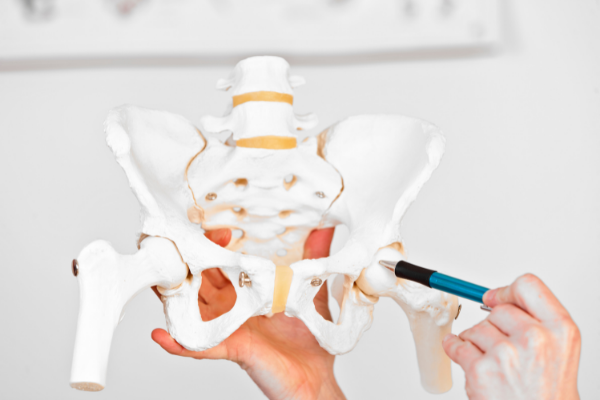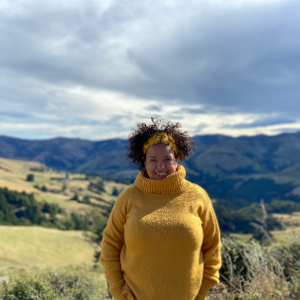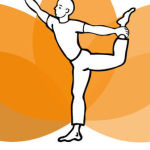By Veronica King, Teaching Yoga and navigating a labral hip tear.

Monday night, advanced yoga class. Parsvakonasana, a warm-up pose early in class, and as I anchored my legs and rotated my body upwards, I felt a rip inside my groin. I nearly screamed, tears streaming down my face through the rest of the class, wondering if this was the last yoga class I might ever do, knowing something BAD had just happened.
It turns out that labral hip tears are common amongst dancers, yogis, golfers, and runners. It was 2017 I had just turned 40, which made me a statistic just waiting to happen.
At the time I was devastated, in pain, and a complete mess.
It turns out this would become a pivotal moment in my practice and my teaching career, a journey from pain and grief, to joy and freedom.
The labrum is a fibrocartilaginous rim, which encompasses the circumference of the acetabulum.
What does it do?
- Deepens the hip socket
- Buffers the forces acting on the hip
- Creates negative pressure inside the hip joint
- Helps with proprioception
A labral hip tear results when part of the labrum separates or is pulled away from the socket. Each tear will present differently, depending on where the tear is.
How do they happen?
- It can be a trauma, eg fall, car accident
- The most common cause is repetitive stress to the hip joint.
- Extremes of motion, repetitive twisting, or sharp movements
- Rotational stress (think end range of motion), hyperextension (eg hanuman), hyperflexion (eg upavistakonasana)
According to one review of labral hip tear literature, 22-55% of patients presenting with groin pain were found to be due to hip labral tear. So if you teach yoga to the public, I’d wager that you have at least come across students with labral tears whether they have known this to be the case or “things just hurt in certain poses”. When students come to ask me about hip pain, I encourage them to ask their doctor to check if it is a tear.
So how does a labral tear feel?
- A deep ache in the front of your hip or groin
- Painful clicking or “catching” with hip movements; the feeling of something painful stuck in the hip or blocking hip motion.
- Pain that increases with prolonged sitting or walking.
- Sharp pain in the hip or groin when squatting.
- Pain that comes on gradually rather than with one specific episode.
- Weakness in the muscles surrounding the hip, or a feeling of the hip “giving way.”
- Stiffness in the hip.
There is so much repeated deep hip movement in our day, in our yoga practice, my grief came from realising that for some time, whilst I was nursing chronic inflammation, the best yoga for me was no yoga.
As my inflammation subsided my personal practice became a journey of discovery and body mapping. What felt ok for today, this practice? I focussed on simple movements and calming meditation. I expanded my observation and awareness off the mat to notice what would “fatigue” my hip to cause pain. I used aqua jogging and the work of Donna Farhi and Leila Stuart, in their brilliant book “Pathways to a Centered Body” for my rehab.
In my teaching, I became obsessed with learning everything about functional movement, balanced and gentle practices. Could I still teach if I could no longer do? For a while, I would sit on a stool at the front of the class (I couldn’t sit on the floor, too much hip flexion) and before teaching I would plan the sequence and visualise it, so I could teach it at the studio. It turns out my teaching had a newfound clarity, students enjoyed the improved sequencing.
In private I would cry on my way home after teaching and each advanced class felt like a painful reminder of what I could no longer do and I was consumed by a feeling of loss. So I retired from regular classes and focussed on gentle yoga, restorative yoga, and yoga nidra.
It turns out I was making space for my yoga soul purpose. “ I look back now, and I can be grateful for what I have learned. I would have been focused on asana and missed the great love of my life, which comes from rest and stillness”.
You might be reading this because you teach others, and want to better support them, or maybe there is a niggle you have been living with and want to understand.
Here are my personal top 5 tips that allowed me to get back on a yoga mat and join in a class:
- Alternate left and right side through neutral. Eg if I do a pose on one side I then come back to a neutral space of tadasana or table pose with a neutral pelvis and neutral spine. No building of multiple poses on the same leg before changing sides, and I only do about a fifth of the uttanasana transitions that are in most classes!
- Focus on hip stabilising vs hip-opening
- Recreate the shape in a less weight-bearing way. The rest of the class doing pigeon pose, not a problem, I’ll be on my back doing a very open figure 4 pose. Almost every pose can be replicated in another plane of space.
- Some poses and shapes will simply not serve you any longer, I said goodbye to most deep forward folds, all compressed flexion twists.
- Play, make it a fun game to figure out what you can do. How can I do something that embodies the quality of the teachings but is right for me?
Personally, I don’t believe things happen for “a reason”, but I do know that we are called to grow and evolve from the cards that we are dealt. My favourite author sums this up perfectly:
“And once the storm is over, you won’t remember how you made it through, how you managed to survive. You won’t even be sure whether the storm is really over. But one thing is for certain. When you come out of the storm, you won’t be the same person who walked in. That’s what the storm is all about.”
Haruki Murakami
References:
- “Pathways to a Centred Body: Gentle Yoga Therapy for Core Stability, Healing Back Pain and Moving with Ease.” Donna Farhi & Leila Stuart
- https://www.michaelcurtispt.com/hip-labrum-tears/#fnref-6
- Groh MM, Herrera J. A comprehensive review of hip labral tears. Current reviews in musculoskeletal medicine. 2009 Jun 1;2(2):105-17.
- https://bjsm.bmj.com/content/37/3/207

Veronica King presented this talk “Don’t Despair the Tear” at the Hauora Yoga Conference 2019, and presented the next evolution of this talk at this year’s virtual conference. She is a certified Level 3 Yoga NZ teacher and accredited facilitator of the Integrative Amrit Method of Yoga Nidra. Until recently, she spent almost 5 years as studio owner of an iconic Christchurch studio and is now enjoying working on her online recorded library theyoganidraproject.com. She is also celebrating all things yoga as the editor of The Yoga Lunchbox. Please note this is an opinion piece and not the official view of the Yoga Lunchbox. This article is not intended to replace professional medical advice.

Leave a Reply